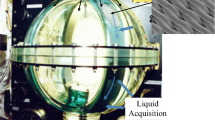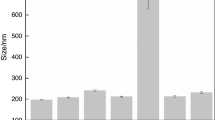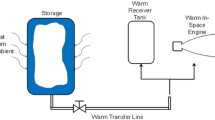Abstract
Metallic woven screen is the core component of a liquid acquisition device (LAD), which is used for the gas–liquid separation of propellants. One of the most important factors that determine the working performance and stability of the LAD is the wicking performance of screens. In order to characterize the wicking capacity and permeability of the screens, the wicking experiments were carried out using five vertically mounted Dutch Twill Weave (DTW) screens and three liquids (acetone, ethanol, and HFE-7500) in the present study. It is shown that the wicking process can be divided into three stages according to the flow characteristics, i.e., initial, intermediate, eventual wicking stages. The wicking height versus time follows h ~ t1/2 and h ~ t1/3 law in the initial wicking stage and intermediate stage, respectively. The eventual wicking stage is characterized by a very small wicking velocity of about 10–5 m/s, which is about one order of magnitude smaller than those of initial and intermediate wicking stages (10–3 ~ 10–4 m/s). The wicking velocity in the initial stage increases with the decrease of screen weave density, and the fluid with larger σ/μ and smaller ρ/μ tends to show larger wicking velocity. Furthermore, the permeabilities K, the effective capillary diameters Dc and the effective wicking diameters Dw of five DTW samples are obtained from the experiments, supplementing the blank of structural parameters of screens with higher weave densities. Parametric analysis was further conducted to validate the reliability by comparing the results of the present study with those in literature. Finally, a dimensionless model is derived by integrating the influence of the working liquid properties, screen structures and evaporation rate into a dimensionless number ξ, which is applied to evaluate and predict working performance for three typical cryogenic propellants LH2, LOX, and LCH4 based on the experimental wicking parameters.











Similar content being viewed by others
Abbreviations
- D c :
-
Effective capillary diameter (m)
- D h :
-
Hydraulic diameter (m)
- D w :
-
Effective wicking diameter (m)
- d :
-
Metal wire diameter (m)
- f :
-
The body force per unit mass (N kg-1)
- h :
-
Wicking height (m)
- K :
-
Permeability (m2)
- K t :
-
Dynamic apparent permeability tensor (m2)
- L s :
-
Screen length (m)
- \(\dot{m}_e\) :
-
Evaporation rate (kg m-2 s-1)
- t :
-
Wicking time (s)
- V m :
-
Volume of metal wire (m3)
- V t :
-
Total volume of screen sample (m3)
- v :
-
Wicking velocity (m s-1)
- \(\langle \mathbf {v}\rangle\) :
-
Superficial average velocity (m s-1)
- W s :
-
Screen width (m)
- α :
-
The closure variable that maps the initial velocity to (m s-1)
- δ s :
-
Screen thickness (m)
- ε e :
-
Effective porosity
- θ :
-
Static contact angle (°)
- μ :
-
Viscosity (Pa s)
- ξ :
-
Integrated control factor
- ρ :
-
Density (kg m-3)
- σ :
-
Surface tension (N m-1)
- DTW:
-
Dutch twill weave
- LAD:
-
Liquid acquisition device
- PMD:
-
Propellant management device
- abs:
-
Absolute
- add:
-
Additional
- cap:
-
Capillary
- hyd:
-
Hydrostatic
- imm:
-
Immersion
- max:
-
Maximum
- s:
-
Shute
- vis:
-
Viscous
- w:
-
Warp
References
Xie FS, Li YZ, Wang L, Ma Y (2017) Feasibility analysis and application consideration of a rapid method to obtain subcooled cryogenic propellants. Appl Therm Eng 118:82–89
McLean C, Pitchford B, Mustafi S, Wollen M, Walls L, Schmidt J (2011) Simple, robust cryogenic propellant depot for near term applications2011 IEEE Aerospace Conf 1–24
Darr S, Hartwig J (2014) Optimal liquid acquisition device screen weave for a liquid hydrogen fuel depot. Int J Hydrogen Energy 39:4356–4366
Hartwig J, Adin Mann J, Darr SR (2014) Parametric analysis of the liquid hydrogen and nitrogen bubble point pressure for cryogenic liquid acquisition devices. Cryogenics 63:25–36
Hartwig J, Darr S (2014) Influential factors for liquid acquisition device screen selection for cryogenic propulsion systems. Appl Therm Eng 66:548–562
Zhang T, deBock P, Stautner EW, Deng T, Immer C (2012) Demonstration of liquid nitrogen wicking using a multi-layer metallic wire cloth laminate. Cryogenics 52:301–305
Kumar P, Wangaskar B, Khandekar S, Balani K (2018) Thermal-fluidic transport characteristics of bi-porous wicks for potential loop heat pipe systems. Exp Therm Fluid Sci 94:355–367
Liu Z, He X, Han J, Zhang X, Li F, Li A, Qu Z, Xu F (2018) Liquid wicking behavior in paper-like materials: mathematical models and their emerging biomedical applications. Microfluid Nanofluid 22:132
Dang-Vu T, Hupka J (2005) Characterization of porous materials by capillary rise method. Physicochem Probl Mi 39:47–65
Geogiou D, Kalogianni EP (2017) Height-time and weight-time approach in capillary penetration: Investigation of similarities and differences. J Colloid Interface Sci 495:149–156
Niu J, Xie N, Gao X, Fang Y, Zhang Z (2020) Capillary performance analysis of copper powder-fiber composite wick for ultra-thin heat pipe. Heat Mass Trans https://doi.org/10.1007/s00231-020-02989-5
Srinivasan V, Kumar S, Asfer M, Khandekar S (2017) Oscillation of an isolated liquid plug inside a dry capillary. Heat Mass Transfer 53:3353–3362
Sheu T-S, Ding P-P, Lo IM, Chen P-H (2000) Effect of surface characteristics on capillary flow in triangular microgrooves. Exp Therm Fluid Sci 22:103–110
Sederman AJ, Gladden LF (2001) Magnetic Resonance Visualization of Single- and Two-Phase Flow in Porous Media. Magn Reson Imaging 19:339–343
Li H, Mo R, Li R, Fan M, Lu Y (2020) Experimental study on drop penetration and wetting characteristics of sintered copper powders with nanostructures. Heat Mass Transfer 56:2883–2891
Symons EP (1974) Wicking of liquids in screens. NASA-TN-D-7657
Fries N, Odic K, Conrath M, Dreyer M (2008) The effect of evaporation on the wicking of liquids into a metallic weave. J Colloid Interface Sci 321:118–129
Camarotti C, Deng O, Darr S, Hartwig J, Chung JN (2019) Room temperature bubble point, flow-through screen, and wicking experiments for screen channel liquid acquisition devices. Appl Therm Eng 149:1170–1185
Grebenyuk Y, Dreyer ME (2016) Wicking of liquid nitrogen into superheated porous structures. Cryogenics 78:27–39
Ma Y, Zimnik D, Dreyer M, Li Y (2019) Investigation on cryo-wicking performance within metallic weaves under superheated conditions for screen channel liquid acquisition devices (LADs). Int J Heat Mass Transfer 141:530–541
Li X, Wang J, Hu Q, Bao L, Zhang H (2013) Experimental and theoretical research on capillary limit of micro heat pipe with compound structure of sintered wick on trapezium-grooved substrate. Heat Mass Transfer 49:381–389
Hastings L, Bolshinskiy L, Schunk R, Martin A, Eskridge R, Frenkel A, Grayson G, Pendleton M (2011) Thermal integration of a liquid acquisition device into a cryogenic feed system. NASA/TP-2011–216474
Ma Y, Li Y, Wang L, Lei G, Wang T (2019) Investigation on isothermal wicking performance within metallic weaves for screen channel liquid acquisition devices (LADs). Int J Heat Mass Transfer 135:392–402
Masoodi R, Pillai KM (2012) Wicking in porous materials: traditional and modern modeling approaches CRC Press
Lucas R (1918) Ueber das Zeitgesetz des kapillaren Aufstiegs von Flüssigkeiten. Kolloid-Zeitschrift 23:15–22
Washburn EW (1921) The dynamics of capillary flow. Phys Rev 17:273
Bosanquet CH (1923) LV. On the flow of liquids into capillary tubes. Philos Mag 45:525–531
Fries N, Dreyer M (2008) An analytic solution of capillary rise restrained by gravity. J Colloid Interface Sci 320:259–263
Fries N, Dreyer M (2009) Dimensionless scaling methods for capillary rise. J Colloid Interface Sci 338:514–518
Stange M, Dreyer ME, Rath HJ (2003) Capillary driven flow in circular cylindrical tubes. Phys Fluids 15:2587–2601
Das S, Mitra SK (2013) Different regimes in vertical capillary filling. Phys Rev E 87: 063005
Quéré D, Raphaël É, Ollitrault J-Y (1999) Rebounds in a capillary tube. Langmuir 15:3679–3682
Wang QG, Li L, Gu JP, Weng N (2019) A dynamic model for the oscillatory regime of liquid rise in capillaries. Chem Eng Sci 209: 115220
Huang G, Yuan W, Tang Y, Zhang B, Zhang S, Lu L (2017) Enhanced capillary performance in axially grooved aluminium wicks by alkaline corrosion treatment. Exp Therm Fluid Sci 82:212–221
Tang Y, Deng D, Lu L, Pan M, Wang Q (2010) Experimental investigation on capillary force of composite wick structure by IR thermal imaging camera. Exp Therm Fluid Sci 34:190–196
Shirazy MRS, Fréchette LG (2013) Capillary and wetting properties of copper metal foams in the presence of evaporation and sintered walls. Int J Heat Mass Transfer 58:282–291
Lasseux D, Valdès-Parada F, Bellet F (2019) Macroscopic model for unsteady flow in porous media. J Fluid Mech 862:283–311
Fries N, Odic K, Dreyer M (2007) Wicking of perfectly wetting liquids into a metallic meshProceedings of the 2nd International Conference on Porous Media and its Applications in Science and Engineering, ICPM2, Kauai, Hawaii, USA. 2007
Ponomarenko A, QuÉRÉ D, Clanet C (2011) A universal law for capillary rise in corners. J Fluid Mech 666:146–154
Zarandi MAF, Arroyo S, Pillai KM (2019) Longitudinal and transverse flows in fiber tows: Evaluation of theoretical permeability models through numerical predictions and experimental measurements. Compos Part A-Appl S 119:73–87
Berdichevsky AL, Cai Z (1993) Preform permeability predictions by self-consistent method and finite element simulation. Polym Compos 14:132–143
Gebart BR (1992) Permeability of unidirectional reinforcements for RTM. J Compos Mater 26:1100–1133
Van der Westhuizen J, Prieur Du Plessis J, (1996) An attempt to quantify fibre bed permeability utilizing the phase average Navier-Stokes equation. Compos Part A-Appl S 27:263–269
Latief FDE, Fauzi U (2012) Kozeny-Carman and empirical formula for the permeability of computer rock models. Int J Rock Mech Min 50:117–123
Davies CN (1953) The Separation of Airborne Dust and Particles. P I Mech Eng G-J Aer 167:185–213
Koponen A, Kandhai D, Hellén E, Alava M, Hoekstra A, Kataja, Niskanen K, Sloot P, Timonen J (1998) Permeability of Three-Dimensional Random Fiber Webs. Phys Rev Lett 80:716–719
Tomadakis MM, Robertson TJ (2005) Viscous Permeability of Random Fiber Structures: Comparison of Electrical and Diffusional Estimates with Experimental and Analytical Results. J Compos Mater 39:163–188
Knackstedt MA, Duplessis JP (1996) Simple permeability model for natural granular media. Geophys Res Lett 23:1609–1612
Acknowledgements
This research is supported by the National Natural Science Foundation of China under the contract No. 51976117 and the fund of Shanghai Research Center of Advanced Aerospace Technology under the contract No. USCAST2019-4. A part of the characterizations is conducted in the AEMD of Shanghai Jiao Tong University.
Author information
Authors and Affiliations
Corresponding author
Ethics declarations
Conflict of interests
The authors declare that they have no known competing financial interests or personal relationships that could have appeared to influence the work reported in this paper.
Additional information
Publisher's Note
Springer Nature remains neutral with regard to jurisdictional claims in published maps and institutional affiliations.
Rights and permissions
About this article
Cite this article
Zhu, Q., Jiang, Y., Zhang, P. et al. Liquid wicking flow characteristics in metallic screens with various weave densities. Heat Mass Transfer 58, 719–734 (2022). https://doi.org/10.1007/s00231-021-03128-4
Received:
Accepted:
Published:
Issue Date:
DOI: https://doi.org/10.1007/s00231-021-03128-4




